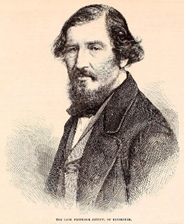William Edmondstoune Aytoun
1813-1865
A Scottish poet and professor of rhetoric and belles lettres at the University of Edinburgh. In the early 1850s, Aytoun lent his name as a supporter of the fledgling National Association for the Vindication of Scottish Rights. He published his first book, Poland, Homer, and other Poems, in 1832, at the age of 19. This work expressed fervent concern for the cause of Poland. In 1833 he journeyed on to Aschaffenburg where he studied German. On returning to Scotland in 1834, Aytoun resumed his legal studies in his father's chambers and was admitted a writer to the signet in 1835, and five years later certified a Scottish lawyer. By his own confession, though he followed the law, he never could "overtake" it. He was a contributor to Blackwood's, beginning in 1836 with his translations from Uhland. In 1839 he joined its staff, an association which he maintained until the end of his life. His contributions included humorous prose stories, such as The Glenmutchkin Railway, How I Became a Yeoman, and How I Stood for the Dreepdaily Burghs; a partly autobiographical novel, Norman Sinclair, and the work upon which his reputation as a poet is chiefly based, his Lays of the Scottish Cavaliers (1848). His reputation as a keen satirist is demonstrated by his dramatic verse Firmilian, a Spasmodic Tragedy, or The Student of Badajoz (1854) under the nom-de-plume of T. Percy Jones, a mock-tragedy in which he parodied the poems of the Spasmodic poets. It was intended to satirise a group of poets and critics, including George Gilfillan, Sydney Thompson Dobell, Philip James Bailey, and Alexander Smith. His parody played a decisive role in ending the vogue for such works. In 1845, Aytoun was appointed Professor of rhetoric and belles lettres at the University of Edinburgh. His lectures attracted large numbers of students, raising the attendance from 30 to 150. His services in support of the Tory party, especially during the Anti-Corn-Law struggle, received official recognition with his appointment in 1852 as Sheriff of Orkney and Shetland, a role he served for 13 years. He was married to Jane Emily Wilson, the daughter of Professor John Wilson (Christopher North). She died in 1859 and he then remarried, his second wife being Fearnie Jemima Kinnear, who died in 1904. He had no children by either wife. He is buried close to Professor Wilson in the Dean Cemetery in Edinburgh.
